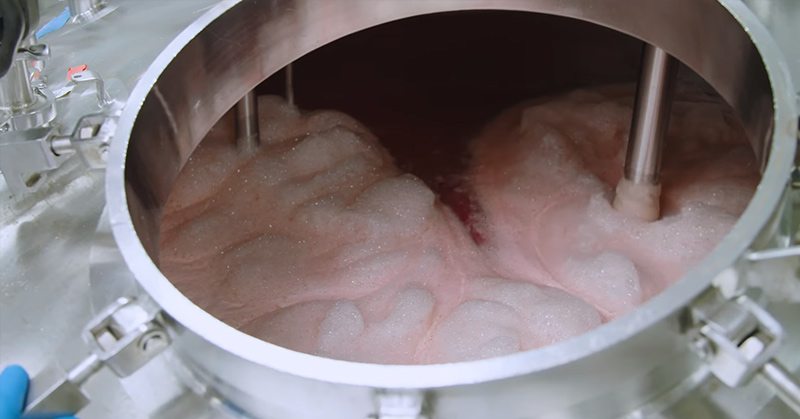This article was originally published in 2017 and has since been updated.
The Impossible Burger is selling out at popular grocery stores, but most people have no idea how it’s actually made…
I first heard about the Impossible Burger from my best friend, who is vegan. She told me that while ordering out with coworkers at lunch, both meat and non-meat-eaters alike ordered the burger, and everyone was impressed—in fact, many of the meat-eaters couldn’t tell the difference between this plant-based burger and real meat.
With all the hype this burger has been getting—including a phone call from my Italian meat-eating neighbor who said she almost couldn’t tell the difference either—it’s natural to wonder what all the fuss is about, and to wonder if the Impossible Burger’s ingredients are worth being impressed about.
What exactly was in this particular burger that made it so different from the cardboard-tasting veggie burgers I’d had in the past? This six-minute 2017 video posted by WIRED explains (and shows) how the Impossible Burger is made—and the secret includes some genetic engineering by the team at Impossible Foods.
It’s a little strange watching technicians make food in a lab, I’ll admit. But, if you’ve ever seen Earthlings—or any other type of documentary about the life of animals in the food industry, for that matter—you’ll find that it’s generally more peaceful and alluring that watching a cow get killed in a slaughterhouse.
Let’s dig a little deeper into what the Impossible Burger offers as well as address some skepticisms people have about it—and what all this could mean for the future of food, our planet, and our health.
Is the Impossible Burger Safe?
That ingredient that makes the Impossible Burger different is called heme, also known as soy leghemoglobin. What exactly is this, and how is it made?
Heme is a molecule—more specifically, a protein—that contains iron [1]. It’s present in all life forms, but is especially high in red meat. It’s also found in plants to a certain degree.
However, it’s difficult to get the volume of heme that Impossible Foods would need to make all the Impossible Burgers (not to mention other Impossible products) they need to meet current demand. The solution? To engineer a yeast called Pichia pastoris to produces large quantities of leghemoglobin [2]. In fact, an entire acre of soy can only naturally produce 1kg of leghemoglobin [3], hence the need for the modified yeast.
Tentative research shows that this yeast and its heme yield are “unlikely to present an unacceptable risk of allergenicity or toxicity to consumers”, and that this compound is similar in structure to mammalian myoglobins (proteins) that are frequently consumed [4].
However, it’s important to note that this research hasn’t been carried out over the long-term, and hasn’t been conducted on humans—two factors that some would argue are essential in determining a product’s safety.
Others have concerns over the amount of soy in the product, which can influence the body’s estrogen levels, although these claims have been debunked and currently don’t have much merit [5]. The Impossible Burger does have roughly the same amount of protein as a regular burger, and it has some added nutrients such as B vitamins, which some people who eat plant-based diets are lacking in, and more fiber than a conventional burger.
However, people who need to be mindful of their salt intake should take note that a single Impossible Burger has 370 mg—and this doesn’t include all the toppings a restaurant may choose to serve it with, including buns, which could push it to over 1,000 mg (as we see in Burger King’s Impossible Whopper).
The Impossible Burger also delivers a more bioavailable form of iron to the body through heme, similarly to the type found in meat, which is generally considered to be better absorbed than the iron found in plants [6].
The Downside—It Does Contain Allergens and GMOs
Currently, Impossible Foods is in the process of switching over their current recipe for the Impossible Burger—which contains gluten—with a version that replaces the wheat protein with soy.
Is this better? Soy is still a common allergen, and some people avoid soy for other health reasons [7]. Others still—myself included—avoid soy that’s been genetically modified. The heme and soy in the Impossible Burger are genetically modified. In May 2019, Impossible Foods announced that, due to demand, it would switch from non-genetically engineered soy that it previously used to genetically engineered soy [8].
Other people have concerns about the use of glyphosate, which the International Agency for Research on Cancer (IARC) says is likely carcinogenic to humans, in the Impossible Burger [9]. While not on the list of ingredients, glyphosate is an herbicide used when growing genetically engineered crops such as soy and has been shown to harm the health of humans, animals, and our environment [10]. In fact, forms of this herbicide have recently been banned in France, the Netherlands, and Belgium for household use. [11].
Another herbicide of concern is 2,4-Dichlorophenoxyacetic acid as some studies have linked it to non-Hodgkins lymphoma [12].
How Affordable Is the Impossible Burger Compared to Meat?
My husband and I buy grass-fed, organic, humanely-raised meat from a local ranch where we personally know the family who raises the cattle. We pay about $7 for a pound of ground beef here.
The average price for ground meat at the store is between $3-$8, whereas the Impossible Burger sells 12 ounces (which is less than a pound) for $9 [13].
Needless to say, this is quite a price difference, especially for people who are used to buying cheaper meat at the supermarket.
You’re getting the same amount of calories per burger, but slightly more total fat than a regular burger. The company also uses coconut oil, which is known for being high in saturated fat. However, it’s new gluten-free version—which will overtake all versions of the Impossible Burger available on the market—will contain a blend of coconut and sunflower oil, which will bring its saturated fat content down.
You’re getting 9 grams of carbs with the Impossible Burger (compared to 0 in a regular burger) and 25 percent of your daily iron, compared to 16 percent in a regular burger [14].
While not exactly affordable, the pricing of the Impossible Burger could be enough to convince people to eat less meat or fewer imitation meat products and focus more on plants and whole foods—which are, arguably, better for our health and our planet anyway.
Is the Impossible Burger Healthy for Us—or Good for Our Planet?
When it comes to reducing our consumption of unethically-produced animal products, the Impossible Burger certainly has its place.
But nothing comes without cost, and the growing concern about genetically engineered foods and the effort made to put ever more healthy, nutritious, and healing foods into our bodies and the bodies of our children may be part of a picture that doesn’t include the Impossible Burger.
If you have the time, money, and willpower, it’s simple enough to make a much more nutritious burger that doesn’t contain animal products at home. However, for plant-based eaters trying to satisfy meat-eaters when entertaining, or for those who need to grab something quick to make for dinner, the Impossible Burger is a viable option.
In the end, what’s best for our bodies and our planet are part of a bigger solution that goes much deeper than healthwashing would have us believe—and it’s one we all would do well to take note of.
Sources
- New Food Economy
- “The Microbial Reasons Why the Impossible Burger Tastes So Good.” ASM. May 16, 2019.
- “The Impossible Burger: Inside the Strange Science of the Fake Meat That ‘Bleeds’.” Wired. Matt Simon. September 20, 2017.
- “Evaluating Potential Risks of Food Allergy and Toxicity of Soy Leghemoglobin Expressed in Pichia pastoris.” NCBI. Yuan Jin, et al. January 2018.
- “Dear men: There’s no evidence that eating Impossible Whoppers will give you breasts.” Washington Post. Tim Carman. December 26, 2019.
- “Iron bioavailability of hemoglobin from soy root nodules using a Caco-2 cell culture model.” NCBI. Amy K Proulx and Manju B Reddy. February 2006.
- “Soy Allergy.” Food Allergy
- “How our commitment to consumers and our planet led us to use GM soy” Medium. Pat Brown. May 16, 2019.
- “Glyphosate: Cancer and other health concerns.” USRTK. Stacy Malkan. December 4, 2023.
- “French court bans sale of controversial weedkiller.” Nature. Barbara Casassus. January 24, 2019.
- “Non-Hodgkin Lymphoma and Occupational Exposure to Agricultural Pesticide Chemical Groups and Active Ingredients: A Systematic Review and Meta-Analysis.” NCBI. Leah Schinasi and Maria E. Leon. April 2014.
- “The Impossible burger has 1 major flaw to overcome: It’s nearly triple the price of normal ground beef.” Business Insider. Ben Gilbert. September 28, 2019.
- “What Are The Nutrition Facts For Impossible™ Beef Made From Plants?” Impossible Food.

